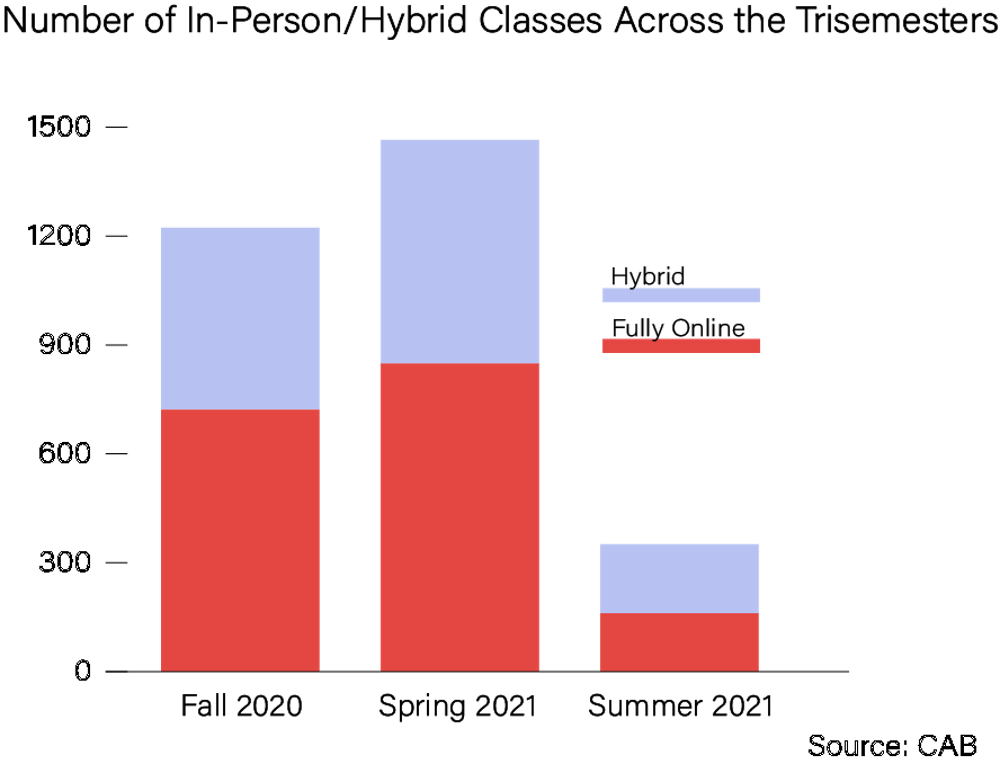When Professor of Africana Studies Lisa Biggs walked into the Friedman Hall lecture room of her course, AFRI 0300: “Performing Ethnography and the Politics of Culture,” she was met with a surprising sense of anxiety. After 15 months of social distancing protocols, stepping into a room of 19 students was just “a bit stressful.”
Despite the initial distress of the first weeks of in-person learning, which began May 19 for classes of 19 or fewer students, Biggs stands alongside other University professors and students in their excitement for a return to classes that more closely resemble pre-pandemic learning.
“I am still cautious and get no joy teaching through my mask,” Biggs wrote in an email to The Herald, referencing the University’s policy that students and professors remain masked and socially distanced in class. But “there is nothing quite like the ‘secret sauce’ that occurs when students and faculty come together unfiltered, unmediated and in person for intellectual and artistic exchanges.”
Kelsey Cooper ’24 is finding similar results from her in-person classes. “Being in person makes it easier to facilitate discussion and class participation,” Cooper said. “Being able to interact with classmates face-to-face makes it easier to connect and engage.”
Professor Constantine Dafermos, who is teaching APMA 0200: “Introduction to Modeling,” also feels that “teaching in person improves the connection” he has with students,” he said. “It’s a completely different feeling to when you have to look at one another through a screen.”
Many students are finding the change refreshing, with Hannah Julius ’24 saying that longer classes are “mentally draining” and “hard to focus on” when held over Zoom.
But while in-person classes have been a welcomed change, some students have still not fully transitioned, with hybrid classes making up a majority of their schedules.
“Hybrid classes are definitely not as effective,” Cooper said. “Having half the class in person and the other half on Zoom introduces technical difficulties, and you can tell it’s difficult for the professor to try and balance the two groups of students.”
Despite such critiques, Professor of English Philip Gould wrote in an email to The Herald that students still “desire this in-person component.”
For many first-years, who make up the majority of the student body on campus this summer term, these are the first normal class experiences they’ve had in college.
“It’s not ideal,” Gould wrote, but “it’s the best we can do.”
In-person classes have allowed many students to engage with University resources for the first time as well.
“These classes remind me that I am actually in school,” Cooper said. “I get to go into the buildings and actually experience everything the University provides. I have a totally new appreciation for being in the classroom again.”
Cooper added that many of her classes engage some form of art, design or architectural elements, so learning is made much easier with hands-on instruction.
Biggs found the in-person component of classes especially useful for her ethnography class, which is heavily based around the research and observation of human life.
Some students, however, don’t want remote learning to be entirely phased out.
“For more lecture-heavy classes, I enjoy online learning because it gives more flexibility in terms of being able to rewatch lectures and all,” Julius said. “Remote office hours for (computer science) are really convenient, but I don’t have any pre-pandemic experience to compare them to.”
Cooper said that depending on COVID-19 policies in the fall regarding mask-wearing, some courses, including language classes, may be better suited to remain online, “just because the visual facial cues are helpful, and masks sometimes muffle our words.”
Whether a full transition back to in-person operations occurs or not, certain professors are making sure to incorporate pandemic teaching techniques into their in-person courses.
Biggs reflected on how teaching online and developing virtual events “opened up (her) awareness about accessibility.” Though the screen can often be a hindrance, Zoom also allows for new and meaningful ways of participation for students “who otherwise might have struggled to speak in class.”
With documented on-campus vaccination rates among students quickly increasing, reaching 76.8 percent as of June 4, students are hoping for more in-person opportunities.
“Given the situation on campus, (the University) could relax the rules a little and maybe let classes of less than 30 be in person once we hit 90 percent,” Julius said. “But who knows, we haven’t gotten to that point yet.”
For Biggs, it is most important to take meaningful lessons away from the pandemic.
“We all deserve a better world. … COVID is never going away completely, but I hope that we will work together to mitigate its effects and build better public health,” Biggs said. “I hope many of us will continue to work to eliminate barriers to teaching and to learning.”

Alex Nadirashvili was the managing editor of multimedia and social media for The Brown Daily Herald's 133rd Editorial Board. As a former University News editor, he covered faculty, higher education and student life, though his proudest legacy is The Brown Daily Herald TikTok account.





